Andrew Cartmel's Blog, page 8
October 6, 2019
Ready or Not by Busick & Murphy
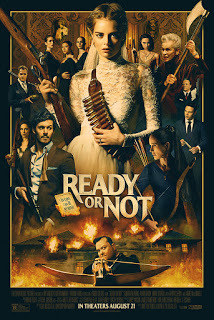 This is a terrific little horror movie with a sly sense of humour, and it's still in cinemas now so I'd urge you to check it out on the big screen.
This is a terrific little horror movie with a sly sense of humour, and it's still in cinemas now so I'd urge you to check it out on the big screen.Ready or Not is essentially a non-supernatural horror story, with a potential supernatural mechanism hovering in the background — but we'll get to that in a minute.
It's the tale of the wealthy Le Domas family whose fortune is founded on a line of board games — we see an amusing array of vintage boxes on display in the first shot.
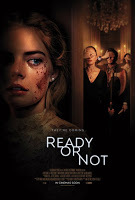 Ready or Not has an implicit line of commentary about what shits rich people really are, and it soon turns out that the Le Domas clan have an odd ritual whenever an outsider marries into the family.
Ready or Not has an implicit line of commentary about what shits rich people really are, and it soon turns out that the Le Domas clan have an odd ritual whenever an outsider marries into the family.The groom — or bride, in this case — is invited to play a game. Exactly which game is determined by drawing cards. And so long as the game isn't hide and seek, everything is fine.
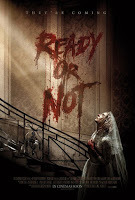
If it is hide and seek, though, the newcomer is in trouble, because the family will arm themselves and hunt down their prey and kill them.
(All of this is established very early on in the movie so it isn't really a spoiler.)
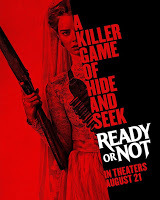 And of course in our movie the bride Grace (an excellent Samara Weaving) draws the hide and seek card. If she survives until dawn she will be spared — not because the family will let her go, but because they will all be destroyed.
And of course in our movie the bride Grace (an excellent Samara Weaving) draws the hide and seek card. If she survives until dawn she will be spared — not because the family will let her go, but because they will all be destroyed.This is where the supernatural element comes in. Because the Le Domas family's fortune was founded on the historical beneficence of a certain Mr Le Bail — whom they believe to have been Satan.
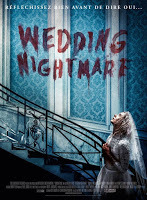 Yes, they made a pact with the devil. (Le Bail is a clever name; it took me a while to realise it was an anagram of Belial!)
Yes, they made a pact with the devil. (Le Bail is a clever name; it took me a while to realise it was an anagram of Belial!)It doesn't much matter whether there really is a deal with the devil, what matters is that the Le Domas family believes there is. They are convinced that if the outsider isn't sacrificed they will all themselves be wiped out.
 So, "The bride must die by dawn!" as Aunt Helene (the fabulous Nicky Guadagni) shrills.
So, "The bride must die by dawn!" as Aunt Helene (the fabulous Nicky Guadagni) shrills. And the hunt is on, with Grace only realising what is at stake when the coked up Emilie (Melanie Scrofano, another great performance) accidentally kills one of the family's — rather creepy — maids.
In fact, the death of the maids becomes a running gag with the reluctant young Le Domases asking if these collateral casualties might serve as the necessary sacrifice, leading to the memorable lines, "Does the help count?" and "Put the maids in the goat pit."
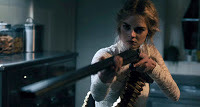 The script is by Guy Busick and Ryan Murphy and besides being thrillingly and cheekily funny it also touches upon profundity: "You'll do pretty much anything if your family says its okay."
The script is by Guy Busick and Ryan Murphy and besides being thrillingly and cheekily funny it also touches upon profundity: "You'll do pretty much anything if your family says its okay."With its blend of bloodshed and sardonic wit, Ready or Not calls to mind Heathers and Happy Death Day. It's a quality piece of work and well worth your attention.

(Image credits: the three official posters are from Imp Awards. The red poster, apparently unofficial, is from Pinterest. The Wedding Nightmare poster and Samara with the shotgun are from from IMDB. The bloodspattered face and arrow in the mouth collage is from Mashable India. The Hong Kong poster is from CinemaHK.)
Published on October 06, 2019 02:02
September 29, 2019
Once Upon a Time in the West by Leone, Donati, Bertolucci & Argento
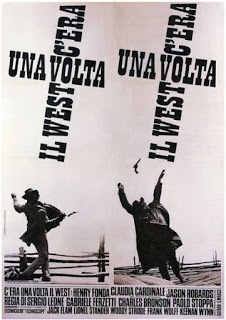 I had never really seen this movie properly. I might have watched a butchered version on television, but I'm sure I never saw a decent print in its entirety.
I had never really seen this movie properly. I might have watched a butchered version on television, but I'm sure I never saw a decent print in its entirety.There were a couple things which motivated me to finally catch up with it...
Christopher Frayling, a critic and writer I admire tremendously has written a huge, beautiful and definitive new book about the film.
 And of course Quentin Tarantino's latest movie, Once Upon a Time in Hollywood is in many ways a homage to Leone's picture.
And of course Quentin Tarantino's latest movie, Once Upon a Time in Hollywood is in many ways a homage to Leone's picture.In 1966 Sergio Leone had just had three hits in a row with his ground breaking and earthshaking series of movies with Clint Eastwood (A Fistful of Dollars, For a Few Dollars More and The Good, the Bad and the Ugly).
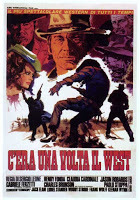 Understandably, he was keen to leave westerns behind and make a different kind of film. What he had in mind was a gangster epic set in New York. (This would eventually become Once Upon a Time in America in 1984.)
Understandably, he was keen to leave westerns behind and make a different kind of film. What he had in mind was a gangster epic set in New York. (This would eventually become Once Upon a Time in America in 1984.)But the American studio Paramount, while keen to work with Leone, preferred that he do one more western, expecting another box office bonanza.
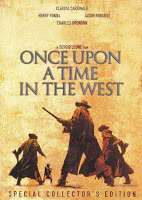
What they got instead was an utterly different kind of movie, one which reinvented the western.
It is long (nearly three hours), slow moving, and almost bereft of dialogue. I would compare it to a great movie of the silent era, except its music is so important.
 The score by Ennio Morricone is devastating. Morricone had collaborated with Leone from the beginning, and they had created three classic films with three unforgettable scores, but this time the men had the time and money to fulfil a dream.
The score by Ennio Morricone is devastating. Morricone had collaborated with Leone from the beginning, and they had created three classic films with three unforgettable scores, but this time the men had the time and money to fulfil a dream.Morricone's themes were written before shooting began and the music was played on the set to create a mood for the actors (something Quentin Tarantino still does).

And scenes in the film were created and edited to match Morricone's score, instead of the other way around.
Given all this, it's fascinating that the famous opening sequence features no music at all. In this three killers wait at an abandoned station for a late train, so they can ambush and kill Charles Bronson.

Morricone and Leone tried music here and it didn't work. So Morricone suggested instead that they use natural sounds — like the iconic squeaking windmill. It works fantastically well, and given that it's Morricone's concept, in an odd kind of way it is also his composition.
 Once Upon a Time in the West was shot in Spain, Italy and Arizona at exactly the same time Sam Peckinpah was shooting another game-changing western in Mexico, The Wild Bunch.
Once Upon a Time in the West was shot in Spain, Italy and Arizona at exactly the same time Sam Peckinpah was shooting another game-changing western in Mexico, The Wild Bunch.But whereas The Wild Bunch was an immediate box office success, Leone's movie, released in America in 1968 in a shortened version, was a financial disaster there and in other English speaking territories.
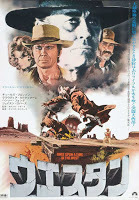 However, it was a big hit in France, Germany and Spain. And in the years since its release it has come to be acknowledged as a classic.
However, it was a big hit in France, Germany and Spain. And in the years since its release it has come to be acknowledged as a classic.Interestingly, Stanley Kubrick, another maker of long, slow films was a great admirer of Once Upon a Time in the West.
And of course Tarantino loves it: "it really illustrated what a director could do with the medium."
 Leone's movie is incredible visually, with inspired set design and costumes by Carlo Simi and luminous photography by Tonino Delli Colli which balances long shots of landscapes with immense close ups of faces.
Leone's movie is incredible visually, with inspired set design and costumes by Carlo Simi and luminous photography by Tonino Delli Colli which balances long shots of landscapes with immense close ups of faces.And what faces they are — the granite countenance of Charles Bronson, who would become a star as a result of this film, the feral beauty of Claudia Cardinale, and the cold blue eyes of Henry Fonda.
 Fonda, who for decades had been a symbol of heroic decency in Hollywood films, is here reinvented by Leone as a profoundly evil killer.
Fonda, who for decades had been a symbol of heroic decency in Hollywood films, is here reinvented by Leone as a profoundly evil killer.If you have three hours or so to spare and a good wide screen television, I'd suggest having a look at a DVD of this film, or perhaps the new Blu-ray.
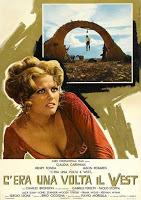 It is slow, sometimes silly (Kung Fu style sound effects for punches), has dubious sexual politics...
It is slow, sometimes silly (Kung Fu style sound effects for punches), has dubious sexual politics...But it's a masterpiece.
 (Image credits: the posters are all from the Movie Poster Shop. They have a great selection and deserve your business.)
(Image credits: the posters are all from the Movie Poster Shop. They have a great selection and deserve your business.)
Published on September 29, 2019 01:34
September 22, 2019
A Place Called Hope: the real life background to The Mousetrap
 When I read Agatha Christie's The Mouse Trap recently, the most striking aspect for me was the horrific episode of cruelty to children which was at the heart of the plot.
When I read Agatha Christie's The Mouse Trap recently, the most striking aspect for me was the horrific episode of cruelty to children which was at the heart of the plot.  This is the tightly coiled spring that powers this classic drama about murder and revenge.
This is the tightly coiled spring that powers this classic drama about murder and revenge.So I was riveted by a BBC Radio documentary about the true crime case which inspired Agatha Christie to write her play.
 It is such an important element in The Mousetrap — and such an unforgettable tragedy — that I thought I'd write about it briefly here.
It is such an important element in The Mousetrap — and such an unforgettable tragedy — that I thought I'd write about it briefly here. (Don't worry, this won't involve giving away any spoilers about the play itself.)
It's a story of two Welsh brothers, Terry and Dennis O'Neill. They were 9 and 12 years old in 1944 when they were taken out of a loving but terribly impoverished family and put into the care of the authorities, supposedly for their own good.
 The boys were rehoused with an English farmer and his wife in a place called Hope. The name was horribly at odds with the fate of the O'Neill brothers, who were ruthlessly starved and beaten.
The boys were rehoused with an English farmer and his wife in a place called Hope. The name was horribly at odds with the fate of the O'Neill brothers, who were ruthlessly starved and beaten.Just to give some idea of the historical context... You may have heard the expression "rule of thumb." Well this originated in the ruling that you could beat your child — or your wife — with a stick.
 Just so long as it was no thicker than your thumb.
Just so long as it was no thicker than your thumb. At the farm in Hope, Dennis O'Neill was beaten hundreds of times a night with a (thinner than your thumb) stick.
Finally, one dreadful night in January 1945, the farmer went too far and, in a fit of rage, killed the boy.

The incident was so ghastly that it drove the war off the front pages of the newspapers and led to profound and much needed reforms of the way children are treated in social care, and resulted in the Children Act of 1948.
The case also made an indelible impression on Agatha Christie. The terrible winter when the killing took place is immortalised in her play, along with a variation on the cruel situation itself.
 The radio documentary I mentioned above is centred on Terry, the surviving brother. He had never seen The Mousetrap, so the interviewer takes him to London and buys him a ticket.
The radio documentary I mentioned above is centred on Terry, the surviving brother. He had never seen The Mousetrap, so the interviewer takes him to London and buys him a ticket.When asked afterward about his reaction to the play, he says "I thought it was fantastic."
And when asked if he ever had a desire for revenge, like the one that drives this drama, he says no.
"It would put me in the same category as the person that's got these evil intents."
Hear hear.
 (Image credits: 64th Year is from a Ticketmaster Blog which has some nice facts about the show. The seven figures in windows are from Walnut Street Theatre. The mice on the keys of the piano are from Maryville University. The guy in the trench coat is from the Experience Theatre Project. The blue poster of the house in snow is from Pinterest. Diamon anniversary is from Quay Tickets. The red poster with the mousehole and cheese is from Western Carolina University. The shadow on the floor poster — which is rather reminiscent of vintage Denis McLoughlin — is from Stage Coach Players.)
(Image credits: 64th Year is from a Ticketmaster Blog which has some nice facts about the show. The seven figures in windows are from Walnut Street Theatre. The mice on the keys of the piano are from Maryville University. The guy in the trench coat is from the Experience Theatre Project. The blue poster of the house in snow is from Pinterest. Diamon anniversary is from Quay Tickets. The red poster with the mousehole and cheese is from Western Carolina University. The shadow on the floor poster — which is rather reminiscent of vintage Denis McLoughlin — is from Stage Coach Players.)
Published on September 22, 2019 11:01
September 15, 2019
Mrs McGinty's Dead by Agatha Christie
 I recently wrote about a superior Poirot novel, and began to get interested in which of his adventures represent the cream of the crop.
I recently wrote about a superior Poirot novel, and began to get interested in which of his adventures represent the cream of the crop.As it happens, the next one I picked up, Mrs McGinty's Dead, the 30th in the series, published in 1952, also qualifies for the top ranking.
The story begins by drawing a more thorough portrait of Poirot, and his inner world, than is usual.The great detective is bored and in need of a challenge. As it happens, one is on its way...
 In the shape of a cop who is sure that an innocent man is facing the gallows. The condemned man is James Bentley, and he was the lodger of one Mrs McGinty, an old woman who was brutally murdered.
In the shape of a cop who is sure that an innocent man is facing the gallows. The condemned man is James Bentley, and he was the lodger of one Mrs McGinty, an old woman who was brutally murdered.Mrs McGinty was a char woman — a woman who cleans people's houses — in a small village called Broadhinny. And the notion of a sleepy, idyllic English village is dismissed very early in the book.
 Superintendent Spence, the cop, says, "Our villages... aren't friendly... Evacuees found that during the war." I imagine Christie had in mind here the savage true life case which inspired her masterpiece The Mousetrap.
Superintendent Spence, the cop, says, "Our villages... aren't friendly... Evacuees found that during the war." I imagine Christie had in mind here the savage true life case which inspired her masterpiece The Mousetrap.And when Poirot goes to Broadhinny to investigate, he is rather a fish out of water. Especially in the dreadful boarding house where he has to stay. The boarding house is run by Mrs Summerhayes (great name), a fun character who is brought emphatically to life in a couple of sentences.

The Summerhayes household is in a state of perpetual chaos... "The cat's been sick again... Those bloody hens are in the larder."
And when our hero tells Mrs Summerhayes that he is Hercule Poirot, expecting awestruck recognition of the great detective, she merely says "lovely name... Greek, isn't it?" Poor Poirot is punctured.
 And when he explains that he's "'Perhaps the most famous detective there is.'" The response is, again, not what he expected:
And when he explains that he's "'Perhaps the most famous detective there is.'" The response is, again, not what he expected:"Mrs Summerhayes screamed with amusement. 'I see you're a great practical joker, M. Poirot'."
 Christie's gift for comedy is seriously under-appreciated, and this whole sequence is a comic tour de force.
Christie's gift for comedy is seriously under-appreciated, and this whole sequence is a comic tour de force.But whatever Mrs Summerhayes may think, Poirot has soon begun to make serious progress on the murder of Mrs McGinty, linking the crime to one of four famous murder cases in the past.
 The trouble is, he doesn't know which one...
The trouble is, he doesn't know which one...Incidentally, one of those cases involved "poisoning by a vegetable alkaloid." By now Christie is, or is at least sounding, a lot more expert about her poisons than she was twenty years ago in Peril at End House.
 And then Poirot is hit by an apple core and suddenly Ariadne Oliver is on the scene, linking up with the great detective for the first time since Cards on the Table. Mrs Oliver is a writer of detective stories and a fun surrogate for Agatha Christie.
And then Poirot is hit by an apple core and suddenly Ariadne Oliver is on the scene, linking up with the great detective for the first time since Cards on the Table. Mrs Oliver is a writer of detective stories and a fun surrogate for Agatha Christie.Indeed Ariadne reflects regretfully on how in one of her books she blundered about pharmacology: "I made sulphanol soluble in water." Here one senses a mea culpa from Christie for her own heroin quills and cocaine chocolates.

The presence of Ariadne as a subsidiary investigator really peps things up, and the story is given even more energy when Poirot acquires another helper in the form of a young woman who is enlisted to assist him, much as Jane Grey did in Death in the Clouds.
 In this case it is the glamorous Maude Williams, whom Poirot sends undercover as a maid in a posh household. Maude has a great line in sarcastic wit and refers to her bosses as "old frozen fish" and "Her Acidity".
In this case it is the glamorous Maude Williams, whom Poirot sends undercover as a maid in a posh household. Maude has a great line in sarcastic wit and refers to her bosses as "old frozen fish" and "Her Acidity".But of course it is Poirot who ultimately cracks the case. And, as always, there is a moment in the story when this silly caricature of a foreigner gets deadly serious.
 "He was no longer a ridiculous little man... he was a hunter very close to his quarry."
"He was no longer a ridiculous little man... he was a hunter very close to his quarry."This is topnotch Christie, fun, fresh and full of vivid characters and witty dialogue.
And it is a distinctive and superior Hercules Poirot novel — indeed it features that very rare occurrence, an attempt on Poirot's own life.
Oh yes, and the solution to the mystery is just beautiful. I never would have guessed it.
(Image credits: The main image with the beautiful, surreal Tom Adams fly is a scan of a copy from my own library. All the others are from Good Reads.)
Published on September 15, 2019 10:08
September 8, 2019
Peril at End House by Agatha Christie
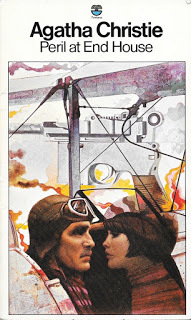 Aha! I'm beginning to sort out the standard Poirot novels from the exceptional ones, and Peril at End House is an exceptional one.
Aha! I'm beginning to sort out the standard Poirot novels from the exceptional ones, and Peril at End House is an exceptional one. It's not a match for the wonderful Five Little Pigs (I'm beginning to think nothing ever will be) but it's right up there with Taken at the Flood as prime Poirot.
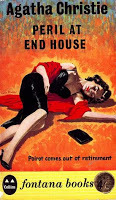 Published in 1932, Peril at End House is the eighth in the series and it begins with Hercule Poirot and his sidekick, the "faithful dog" Major Hastings, on holiday together.
Published in 1932, Peril at End House is the eighth in the series and it begins with Hercule Poirot and his sidekick, the "faithful dog" Major Hastings, on holiday together.They are staying at a hotel on the Cornish coast, which even then was attempting to pass itself off as the English Riviera, leading to some sarcastic comments on page one.
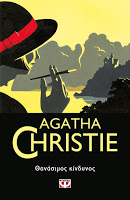 Almost immediately Poirot encounters a captivating young woman, Nick Buckley (groovy name) who, though she doesn't realise it yet, is the subject of a series of murder attempts.
Almost immediately Poirot encounters a captivating young woman, Nick Buckley (groovy name) who, though she doesn't realise it yet, is the subject of a series of murder attempts. But the would-be killer has "made a grave mistake... when he shot at his victim within a dozen yards of Hercule Poirot!"
 Nick lives in a big mansion adjacent to the hotel. Yes, you've guessed it, it's called End House and Nick is the subject of the peril in the title.
Nick lives in a big mansion adjacent to the hotel. Yes, you've guessed it, it's called End House and Nick is the subject of the peril in the title. Her situation puts Poirot in a challenging dilemma, requiring him to "detect a crime before it has been committed — that is indeed of a rare difficulty."
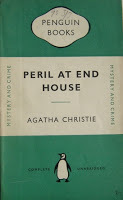 And we are desperate for Poirot to succeed, because Nick Buckley is a great character, immediately vivid in the reader's mind, with her "small impudent dark head" and her fabulous, sardonic dialogue.
And we are desperate for Poirot to succeed, because Nick Buckley is a great character, immediately vivid in the reader's mind, with her "small impudent dark head" and her fabulous, sardonic dialogue.Like when she is talking about her boring lawyer cousin and says, "Charles thinks my mode of life is reprehensible and he disapproves of my cocktails, my complexion, my friends and my conversation. But he still feels my fatal fascination."
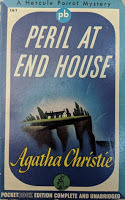
Or in describing the hairdo of her frumpy cousin Maggie, which has "just become fashionable by accident."
And when Poirot comes to call on her, intending to reveal that she is the target of a murder plot, Nick tells him, "I'm devoured with curiosity."
Nick Buckley is a jackpot character and brings out the best in Christie. Also perhaps in Poirot, who seems to feel something of that fatal fascination himself.
Though he does describe Nick as an "allumeuse." It means a kind of posh (if you'll excuse the expression) prick tease.
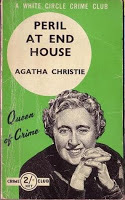 It's a word Christie would use again in Murder in Mesopotamia. Interestingly there is also a ghastly and mysterious face at the window in Peril at End House, as there is Murder in Mesopotamia.
It's a word Christie would use again in Murder in Mesopotamia. Interestingly there is also a ghastly and mysterious face at the window in Peril at End House, as there is Murder in Mesopotamia. But Nick Buckley is brimming with vitality and fun, and so is the book. ("Dr Watson, I presume?" says Nick when she meets Hastings.)
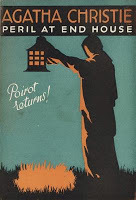 Nick's friend Frederica, also vividly drawn, doesn't hesitate to bad-mouth Nick, calling her "the most heaven-sent little liar that ever existed." And then adding that "loyalty's such a tiresome virtue."
Nick's friend Frederica, also vividly drawn, doesn't hesitate to bad-mouth Nick, calling her "the most heaven-sent little liar that ever existed." And then adding that "loyalty's such a tiresome virtue."The dialogue in this novel is outstanding and Christie is clearly firing on all cylinders.
Even Poirot gets in some zingers. Referring to Hastings' recent sojourn in Brazil, he says, "He has just returned from those great clear open spaces, etc."
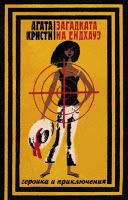 This is the tone of the book — sardonic, full of exuberance and energy. The novel is a breath of fresh air, like that blowing in off the sea in great abundance on the Cornish Riviera.
This is the tone of the book — sardonic, full of exuberance and energy. The novel is a breath of fresh air, like that blowing in off the sea in great abundance on the Cornish Riviera. And it fizzes with life, ironically for a story so focused on death.
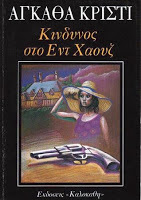 The story's energy dips a bit when Nick is consigned to a nursing home for her own safety ("In the narrow iron bed she looked like a tired child") — although the attempts on her life continue.
The story's energy dips a bit when Nick is consigned to a nursing home for her own safety ("In the narrow iron bed she looked like a tired child") — although the attempts on her life continue.And she remains a supremely terrific character, one of the best in the series so far.
Poirot is also very much on form, with his arrogance firmly intact ("I who am an original").
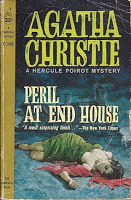
And soon enough he is on the track of the killer and Hastings observes, "His eyes were shining with the queer cat-like green light that I knew so well."
 (This is one of the few occasions where cats serve in a positive fashion in a Christie narrative; they're more normally signifiers of something negative.)
(This is one of the few occasions where cats serve in a positive fashion in a Christie narrative; they're more normally signifiers of something negative.)Peril at End House isn't flawless. There's a murder attempt by slipping cocaine into someone's food. And I simply don't think that could be lethal.
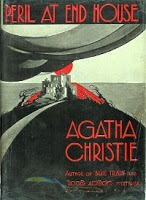 Christie would become quite an expert on poisons, but at this stage there are the weird anomalies like the mysterious "goose quill" used to snort heroin in The Murder of Roger Ackroyd (1926).
Christie would become quite an expert on poisons, but at this stage there are the weird anomalies like the mysterious "goose quill" used to snort heroin in The Murder of Roger Ackroyd (1926).And there's a nasty little hiccup in Peril at End House when a Jewish character, who has up to now has been presented in a refreshingly positive light, is denigrated by Poirot.
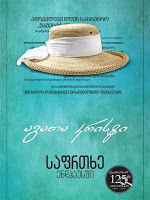 As Charles Osborne puts it in his excellent book on Christie, "You are saddened to hear this from Poirot, who must himself frequently have been the butt of other people's xenophobia."
As Charles Osborne puts it in his excellent book on Christie, "You are saddened to hear this from Poirot, who must himself frequently have been the butt of other people's xenophobia."Yet Peril at End House remains a top drawer Poirot novel. Is it better than Taken at the Flood? Well, the characters and dialogue here are clearly superior.
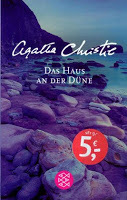 However, the solution to the mystery in Peril at End House — while it is entirely unguessable — doesn't quite have the flabbergasting astonishment factor of the ending of Taken at the Flood.
However, the solution to the mystery in Peril at End House — while it is entirely unguessable — doesn't quite have the flabbergasting astonishment factor of the ending of Taken at the Flood.But it's a close thing.
And I'm looking forward to finding the other finest Poirot adventures, and telling you about them.
(Image credits: The nice Tom Adams cover with the plot-relevant Mauser pistol is scanned from my own copy. The other covers are from Good Reads. I love the yellow Bulgarian one with the rifle sights superimposed on Nick.)
Published on September 08, 2019 02:00
September 1, 2019
The Mousetrap by Agatha Christie
 The Mousetrap is a victim of its own success. It's such a staggeringly popular play — the longest running in history — that it is easy to take it for granted.
The Mousetrap is a victim of its own success. It's such a staggeringly popular play — the longest running in history — that it is easy to take it for granted.In fact, it is such an enduring part of our cultural furniture that it's in danger of becoming completely invisible.
I first saw it, many years ago, in the same way I might have visited the Tower of London. Reluctantly dragged along to this tourist must-see,
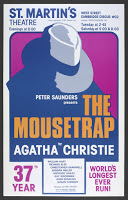 I actually found it very entertaining and I didn't come close to guessing who the killer was.
I actually found it very entertaining and I didn't come close to guessing who the killer was.(And you can relax, I have no intention of giving that away here.)
But it is only recently that I've come to truly appreciate the really quality of this stage classic, when I read the play for the first time.
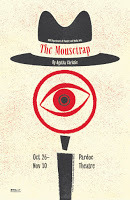
I was immediately struck by the perfect moody, snowbound setting. We are in Monkswell Manor, a rather dingy guesthouse which has been cut off by a blizzard, where the isolated collection of diverse characters are about to become targets for a killer.
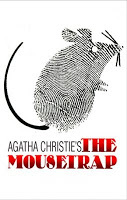 The guest house is run by Mollie and Giles Ralston and the play begins, wittily, with Mollie picking up her husband's coat, scarf and hat while the radio describes the manhunt for a murderer wearing exactly these items.
The guest house is run by Mollie and Giles Ralston and the play begins, wittily, with Mollie picking up her husband's coat, scarf and hat while the radio describes the manhunt for a murderer wearing exactly these items.There are also playful and self-referential scene directions, with one character described as "a slightly taller edition of Hercule Poirot."
 And great dialogue: "Terrible weather isn't it, takes one back to Dickens and Scrooge and that irritating Tiny Tim."
And great dialogue: "Terrible weather isn't it, takes one back to Dickens and Scrooge and that irritating Tiny Tim."That's from the waspish and rather camp Christopher, who also remarks "I adore nursery rhymes, don't you? Always so tragic and macabre."
 And, when a cop called Trotter turns up on skis, he quips "I do admire the police. So stern and hardboiled."
And, when a cop called Trotter turns up on skis, he quips "I do admire the police. So stern and hardboiled."Agatha Christie is adroit at establishing character through dialogue. "All trains should have been met," snaps Mrs Boyle, "a large imposing woman in a very bad temper" who has had to make her own way from the station.
 And there is a further, terrific revelation of character when Mrs Boyle says, "One tries to do a public duty and all one gets is abuse."
And there is a further, terrific revelation of character when Mrs Boyle says, "One tries to do a public duty and all one gets is abuse." This remark refers to the fact that she was a magistrate responsible for sending three young children to a terrible fate.
Which brings us to the most striking thing about The Mousetrap. The murders that take place here aren't arbitrary, for plot convenience.
 They are potently motivated by this horrific episode of child abuse in the backstory, giving the whole play a dark power which drives it forward, and which no amount of comic relief can entirely disguise.
They are potently motivated by this horrific episode of child abuse in the backstory, giving the whole play a dark power which drives it forward, and which no amount of comic relief can entirely disguise. Disturbingly, this incident was based on a true story which I'll write about in another post.
Disturbingly, this incident was based on a true story which I'll write about in another post.But for now, suffice to say that The Mousetrap is one of Agatha Christie's 24-carat masterpieces, and it deserves its enduring and enormous success.
Time I went to see it again...
 (Image credits: The main image of three mice pointing inwards is from Ann Arbor District Library. "Directed by Angela Wright" is from Kickstarter. The Ambassadors Theatre programme is from Arthur LLoyd. The fingerprint mouse is from Birminghmam 365. The mouse and the house is from Columbia County Current. 37th Year is from V&A. The Pardoe Theatre is from the excellent designer Nick Mendoza. The black white and red one is from Curtain Players. New Zealand Players is from Reed Gallery. The Chinese poster is from Pinterest.)
(Image credits: The main image of three mice pointing inwards is from Ann Arbor District Library. "Directed by Angela Wright" is from Kickstarter. The Ambassadors Theatre programme is from Arthur LLoyd. The fingerprint mouse is from Birminghmam 365. The mouse and the house is from Columbia County Current. 37th Year is from V&A. The Pardoe Theatre is from the excellent designer Nick Mendoza. The black white and red one is from Curtain Players. New Zealand Players is from Reed Gallery. The Chinese poster is from Pinterest.)
Published on September 01, 2019 04:04
August 25, 2019
Hickory Dickory Dock by Agatha Christie
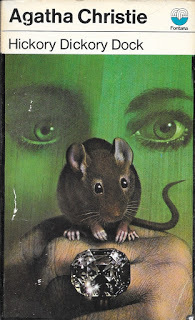 The title of Hickory Dickory Dock will probably baffle non-English readers, and quite a few English ones. It refers to a nursery rhyme.
The title of Hickory Dickory Dock will probably baffle non-English readers, and quite a few English ones. It refers to a nursery rhyme. The connection is utterly tenuous, though — most of the action takes place at a boarding house in Hickory Road, an imaginary location in London.
Agatha Christie was weirdly fond of nursery rhyme titles and had a tendency to crowbar them in where they didn't belong. Possibly the worst example is Five Little Pigs, where she imposed an utterly irrelevant moniker on a masterpiece of a novel.
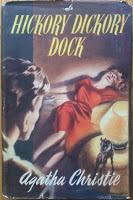 Hickory Dickory Dock isn't in that league, but it's good enough to deserve a better name. Still, the title provided the justification for that Tom Adams cover painting with the cute little mouse on it.
Hickory Dickory Dock isn't in that league, but it's good enough to deserve a better name. Still, the title provided the justification for that Tom Adams cover painting with the cute little mouse on it.This is the 32nd Hercule Poirot novel, published in 1955. It begins with Poirot's faithful, infallible automaton of a secretary Miss Lemon revealing that she has a sister. And that this sister has a problem...
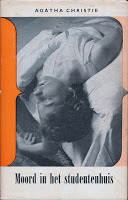 The sister is called Mrs Hubbard (possibly another nursery rhyme reference) and she runs that boarding house I mentioned. It's a student hostel and it is being plagued with a bizarre series of thefts.
The sister is called Mrs Hubbard (possibly another nursery rhyme reference) and she runs that boarding house I mentioned. It's a student hostel and it is being plagued with a bizarre series of thefts.It is refreshingly different to have a Poirot story being set in motion by a crime other than murder — though there will be plenty of murder, too, of course.
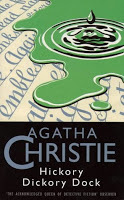 What develops is a fascinating mystery, and Poirot himself is on fine form, "deliberately playing the mountebank"and revealing unsurprisingly that the "sound of his own voice was always pleasant to him."
What develops is a fascinating mystery, and Poirot himself is on fine form, "deliberately playing the mountebank"and revealing unsurprisingly that the "sound of his own voice was always pleasant to him."At the same time his sharp and enquiring mind is very much in evidence. "Everything interests me," he declares. And after one of his awe-inspiring deductions a lawyer remarks, "In the Middle Ages you would certainly have been burnt at the stake."
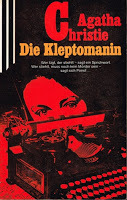 This is the first Agatha Christie I've read from the 1950s, and her transformation is fascinating. Gone are the casually racist attitudes of, say, Death in the Clouds.
This is the first Agatha Christie I've read from the 1950s, and her transformation is fascinating. Gone are the casually racist attitudes of, say, Death in the Clouds.Here Christie is clearly bending over backwards in an attempt to be enlightened and tolerant. There are several non-white characters, including a young West Indian law student called Elizabeth Johnston.
Her intelligence and articulacy are constantly cited. Indeed, she's declared a "a very superior girl."
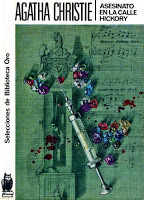 And when the thefts begin at the house in Hickory Road the woman who owns the house suggests that they should simply kick out all "these coloured ones."
And when the thefts begin at the house in Hickory Road the woman who owns the house suggests that they should simply kick out all "these coloured ones.""Not while I'm in charge," responds Mrs Hubbard coldly.
All very admirable. But we also get a dreadfully embarrassing comic turn by the African student Mr Akibombo. Still, full marks for trying, Agatha...
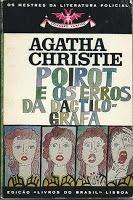 And also for straying so far outside the Christie comfort zone. As Charles Osborne puts it, "she makes a brave and remarkably successful attempt to move, temporarily, with the times, away from the grand country houses or the cosy cottages of St Mary Mead and into the genteel squalor of students' London in the mid-1950s."
And also for straying so far outside the Christie comfort zone. As Charles Osborne puts it, "she makes a brave and remarkably successful attempt to move, temporarily, with the times, away from the grand country houses or the cosy cottages of St Mary Mead and into the genteel squalor of students' London in the mid-1950s."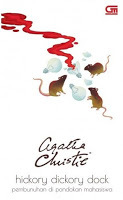 What's more, Poirot's methodical investigation in the story is suitably fascinating, and baffling to the reader: "I dissect rucksacks. It's very interesting," he tells a police colleague. He also does a great bit of ratiocination involving a bowl of soup.
What's more, Poirot's methodical investigation in the story is suitably fascinating, and baffling to the reader: "I dissect rucksacks. It's very interesting," he tells a police colleague. He also does a great bit of ratiocination involving a bowl of soup.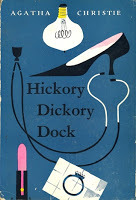 And Christie's storytelling is lively and engaging. One of the students says that if a girl she doesn't like is charged with murder, "I should rejoice madly."
And Christie's storytelling is lively and engaging. One of the students says that if a girl she doesn't like is charged with murder, "I should rejoice madly." While elsewhere another student is searching through a pile of clothes in a woman's room, "burrowing like an excited terrier." Agatha Christie was obviously having fun writing this.
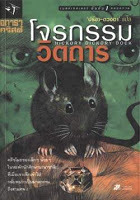 I had a bit of trouble keeping track of the characters — there are a lot of them and they're often referred to just by their first names, but the level of confusion here is certainly nothing like that of The Old Devils by Kingsley Amis.
I had a bit of trouble keeping track of the characters — there are a lot of them and they're often referred to just by their first names, but the level of confusion here is certainly nothing like that of The Old Devils by Kingsley Amis.And the solution to the mystery is suitably unguessable, if a little convoluted.
(Image credits: All the book covers are from Good Reads, except for the main one, the Fontana Tom Adams, which is a scan of my own copy. Besides the two versions of this Tom Adams, with its adorable little mouse, I particularly like the blue Swedish cover featuring a selection of the stolen items.)
Published on August 25, 2019 02:04
August 18, 2019
Once Upon a Time in Hollywood by Quentin Tarantino
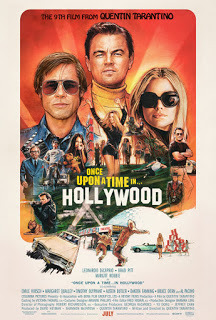 Quentin Tarantino's new film is overlong, deeply self indulgent... and I loved it.
Quentin Tarantino's new film is overlong, deeply self indulgent... and I loved it.Before I went to see it I'd heard criticism from people that it was "not a movie, just a bunch of scenes."
Well, like the film's considerable length, this is a conscious and deliberate line of attack by Tarantino. His movie is, after all, an explicit homage to Sergio Leone's Once Upon a Time in the West...
And here's what Tarantino said about Leone's epic (in Chris Frayling excellent book about that film):
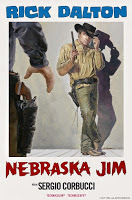
"Whereas in his other movies... he's still trying to tell a story... By the time he made Once Upon a Time in the West he was able to streamline it so that it's just set piece after set piece after set piece."
So, there you have it. Once Upon a Time in Hollywood is also set piece after set piece after set piece.
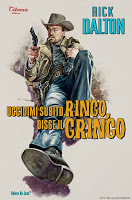 And while there might be one or two of them that are expendable, most are varying degrees of delightful.
And while there might be one or two of them that are expendable, most are varying degrees of delightful.And some are simply stunning.
This is a story of a TV Western star, Rick Dalton (Leo DiCaprio) and his stunt double buddy Cliff Booth (Brad Pitt). Rick is trying to make headway in movies, but his career is on the decline and he's drinking too much.
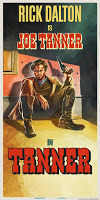 In fact, Rick is so sure that he's washed up that he breaks down in tears outside a restaurant while waiting for the valets to fetch his car.
In fact, Rick is so sure that he's washed up that he breaks down in tears outside a restaurant while waiting for the valets to fetch his car."Don't cry in front of the Mexicans," Cliff admonishes him.
Once Upon a Time in Hollywood is often hilarious, and it lovingly evokes Los Angeles in 1969. At first it's just a rambling series of anecdotes about Rick and Cliff, interweaving them with real people from that time and place.
 Most notably there's a cameo from Damian Lewis, who is an eerily perfect choice with his striking resemblance to Steve McQueen.
Most notably there's a cameo from Damian Lewis, who is an eerily perfect choice with his striking resemblance to Steve McQueen. 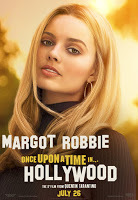 But then we discover that Rick lives next door to Sharon Tate (Margot Robbie) and Roman Polanski (Rafal Zawierucha) on Cielo Drive, the home where Sharon would be savagely murdered by the cult followers of Charlie Manson (Damon Herriman).
But then we discover that Rick lives next door to Sharon Tate (Margot Robbie) and Roman Polanski (Rafal Zawierucha) on Cielo Drive, the home where Sharon would be savagely murdered by the cult followers of Charlie Manson (Damon Herriman).With this revelation Tarantino ingeniously sets a time bomb ticking and we know that however inconsequential and amusing his film may appear to be, it is inexorably heading somewhere very dark and violent indeed.
 It's in the depiction of the Manson family that this film scores most strongly. They are brilliantly cast and performed, giving an impression that is disturbingly off kilter and deeply scary. In particular, Margaret Qualley is indelibly haunting as Pussycat.
It's in the depiction of the Manson family that this film scores most strongly. They are brilliantly cast and performed, giving an impression that is disturbingly off kilter and deeply scary. In particular, Margaret Qualley is indelibly haunting as Pussycat.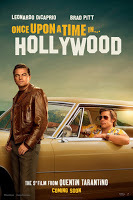
And there's a scene where Cliff goes out to the run-down ranch where the cult members live, which is almost unbearably suspenseful. We are terrified, not knowing if he'll get out of there alive.
Tarantino correctly judges this "one of the best scenes I’ve ever done," and references the work of Peckinpah and Polanski.
He also says, "I had been setting up Cliff as this indestructible guy. And yet you’re afraid for him."(*)
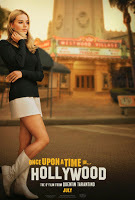
Absolutely right. It's a masterful sequence.
But all the while that time bomb is ticking, and we know we're heading steadily towards that nightmare night on Cielo Drive...
However, this is Quentin Tarantino, who had no hesitation in rewriting the history of World War Two so that Hitler ends up shot dead in a movie theatre.
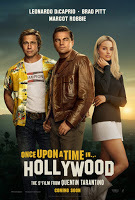
So I was gratified and relieved to see the wild, mind blowing and uproarious climax he fashioned for his new film.
Of course, there's a question to be asked about whether it's acceptable to repurpose such an horrific personal tragedy as a pop culture collage.
But Tarantino apparently made his peace with Sharon Tate's widower, Polanski, and her sister, Debra.
So I suggest we all just relax and enjoy Once Upon a Time in Hollywood — did I mention that it also features Sayuri, who is superb in the role of Cliff's dog, Brandy?
 She gives a great performance despite being fed cans of rat flavoured and raccoon flavoured dog food.
She gives a great performance despite being fed cans of rat flavoured and raccoon flavoured dog food.(*These quotes are taken from an excellent in-depth interview with Tarantino by Mike Fleming at Deadline. Image credits: a wonderful wealth of posters courtesy of Imp Awards.)
Published on August 18, 2019 02:12
August 11, 2019
Midsommar by Ari Aster
 Midsommar is a terrific film but, I think, it's being rather poorly promoted. Flicking through the movies on my cinema website I saw the poster and assumed at first it was a Swedish language remake of A Midsummer Night's Dream...
Midsommar is a terrific film but, I think, it's being rather poorly promoted. Flicking through the movies on my cinema website I saw the poster and assumed at first it was a Swedish language remake of A Midsummer Night's Dream...No, no, no. It's an American horror movie — though it is largely set in Sweden, with the occasional use of subtitles. Don't let that put you off. It's an extraordinary film of genuine hallucinatory power.
 Midsommar is written and directed by Ari Aster, who also made Hereditary, another horror film, and a highly regarded one which I now seriously regret missing on the big screen.
Midsommar is written and directed by Ari Aster, who also made Hereditary, another horror film, and a highly regarded one which I now seriously regret missing on the big screen.The new movie tells the story of Dani (Florence Pugh), a young woman who is so clinging and needy that her boyfriend Christian (Jack Reynor) is eagerly looking for the opportunity to dump her — being encouraged in this by his frat-boy university buddies (including the ever engaging Will Poulter).
 But, in fairness, Dani has damn good reasons to be needy and clingy, as is established by a horrifying family tragedy which we witness in the first few minutes of the film.
But, in fairness, Dani has damn good reasons to be needy and clingy, as is established by a horrifying family tragedy which we witness in the first few minutes of the film.So, in an attempt to repair their relationship, Christian agrees to let Dani come along with him and his buddies on a midsummer vacation jaunt to Sweden. Their agenda being to take magic mushrooms and hit on blonde girls and visit an isolated rural community (where one of the university friends hails from).

One of the striking things about this community is that the inhabitants all dress in white, which means it's easy to pick out the outsiders, even in a long shot.
The place has its own odd beliefs and rituals — and if I mention The Wicker Man at this point, you'll have some idea what is coming, though nothing can quite prepare you for the places Midsommar chooses to go.

Aster is an impressive film maker. There is an early sequence where Christian and his cronies are sitting around a table (stacked with books and bongs) in their apartment, when Dani pays an unwelcome call. The scene is shot with the austere virtuosity of Kubrick.
Midsommar is long, perhaps too long at two and a half hours — another Kubrick trait. But it doesn't drag, and it certainly holds the viewer's attention.
 This is a movie you'll remember long after you leave the cinema. Images that linger include Dani's troubled face, the pupils of her eyes constantly shrunk by the intense perpetual sunlight of midsummer in Sweden, as if to shut out the horrors she is about to witness.
This is a movie you'll remember long after you leave the cinema. Images that linger include Dani's troubled face, the pupils of her eyes constantly shrunk by the intense perpetual sunlight of midsummer in Sweden, as if to shut out the horrors she is about to witness.(Image credits: The three official posters come from Imp Awards. The impressive poster with five faces is from Amazing Zuckonit at Deviant Art. The distinctive grey poster and the one with the flower-faced girl are from the clearly talented Joan of Dyke on Tumblr.)
Published on August 11, 2019 02:00
August 4, 2019
Yesterday by Curtis and Barth
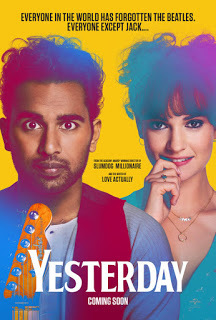 Yesterday is a romantic comedy with a fantasy element. Jack (Himesh Patel) is a struggling young musician who has an accident and is knocked unconscious at the same moment a kind of cosmic time slip takes place.
Yesterday is a romantic comedy with a fantasy element. Jack (Himesh Patel) is a struggling young musician who has an accident and is knocked unconscious at the same moment a kind of cosmic time slip takes place.He wakes up in a world where no one remembers the Beatles or their music. When he eventually becomes certain that this is actually the case Jack does the inevitable — he begins to reconstruct their songs and pass them off as his own.
 This is an oddball premise if ever there was one, and I can't say I found it immediately irresistible. But then I learned that the film was scripted by Richard Curtis, one of the finest British screenwriters, responsible for Four Weddings and a Funeral and Love Actually.
This is an oddball premise if ever there was one, and I can't say I found it immediately irresistible. But then I learned that the film was scripted by Richard Curtis, one of the finest British screenwriters, responsible for Four Weddings and a Funeral and Love Actually.What's more, Yesterday is directed by Danny Boyle, a film maker I admire. He made Trainspotting and Slumdog Millionaire, but for my money his best movie is the masterful Steve Jobs.
So I went to see Yesterday and I was captivated. Himesh Patel is excellent, as is Lily James (Fast Girls, Baby Driver) in the role of his manager and love interest Ellie and the ever reliable Kate McKinnon giving a savagely funny portrait of the big American agent who scoops Jack up.
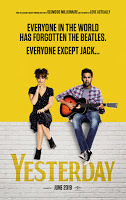 But the most striking aspect of this movie is the music. I'm not the biggest Beatles fan, but the power and attraction of these songs is stunning, especially when they're just being strummed by Jack on his guitar or picked out by him on a piano.
But the most striking aspect of this movie is the music. I'm not the biggest Beatles fan, but the power and attraction of these songs is stunning, especially when they're just being strummed by Jack on his guitar or picked out by him on a piano. This is where the central conceit of the film really pays off. The audience believes that the potency of this music, even pilfered and secondhand, is enough to raise Jack to superstardom in a world that never heard these tunes before.
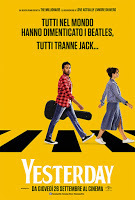 There is an hilarious and excruciatingly and deadly accurate depiction of a local talk show early in the movie, where Jack and 'his' songs are exposed to a TV audience. This leads to Ed Sheeran — playing himself — looking Jack up.
There is an hilarious and excruciatingly and deadly accurate depiction of a local talk show early in the movie, where Jack and 'his' songs are exposed to a TV audience. This leads to Ed Sheeran — playing himself — looking Jack up.Sheeran is terrific and there's a really moving scene where he challenges Jack to a songwriting contest — who can come up with the best one in ten minutes. Jack dusts off 'The Long and Winding Road', and Sheeran is utterly crushed.
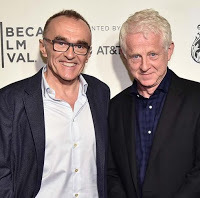 "You're Mozart and I'm Salieri," he says. And naturally Jack doesn't feel great about this. Because none of these songs are really his.
"You're Mozart and I'm Salieri," he says. And naturally Jack doesn't feel great about this. Because none of these songs are really his.Of course, the fact that Jack is living a lie is the dramatic heart of the movie. And I have my reservations about how Richard Curtis resolves the situation. But that's a small criticism of an excellent film.
The more interesting question is the one of authorship, in which the reality of the film somewhat mirrors its story.

Because Richard Curtis didn't create the idea for Yesterday. It was originally a script by Jack Barth. Curtis heard about it, loved the concept, and asked not to be told any more details. Without reading Barth's script, he sat down and wrote his own version.
This was a very interesting approach. Indeed, Curtis's techniques as a screenwriter are fascinating and instructive. You can learn more about them in a fascinating two-part interview here.
 However, the really interesting thing for me was how Curtis never actually mentions Barth's name in the interview, although he's entirely open as to how the film came about.
However, the really interesting thing for me was how Curtis never actually mentions Barth's name in the interview, although he's entirely open as to how the film came about.In fairness, Jack Barth does get a decent screen credit in the finished movie — although I would rather it appeared at the beginning than the end of the picture.
But an even more intriguing question of authorship involves Jack Barth and Jean-Philippe, a 2006 French film written by Laurent Tuel and Christophe Turpin.
 It tells the story of a fan of French singer Johnny Hallyday who falls into a coma and wakes up in a world where no one has ever heard of him.*
It tells the story of a fan of French singer Johnny Hallyday who falls into a coma and wakes up in a world where no one has ever heard of him.*Of course, almost no one outside of France has heard of Johnny Hallyday...
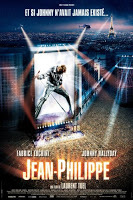
Naturally none of this should interfere with your enjoyment of Yesterday, a perfectly crafted summer feel good film.
And one which will make even die-hard Rolling Stones fans (like me) reconsider the importance of The Beatles.
(*My thanks to the film critic Philip Kemp for drawing attention to this in his review of Yesterday in the July 2019 Sight & Sound magazine.)
(Image credits: The four film posters are from Imp Awards. The photo of the three stars at the premiere is from Reuters. The photo of Danny Boyle and Richard Curtis is from the Hollywood Reporter. The Jean-Philippe poster is from IMDB. The purple-background photo of Jack performing is from the Sun Daily. The shot of him singing in a purple suit is from YouTube via NME.)
Published on August 04, 2019 02:55



